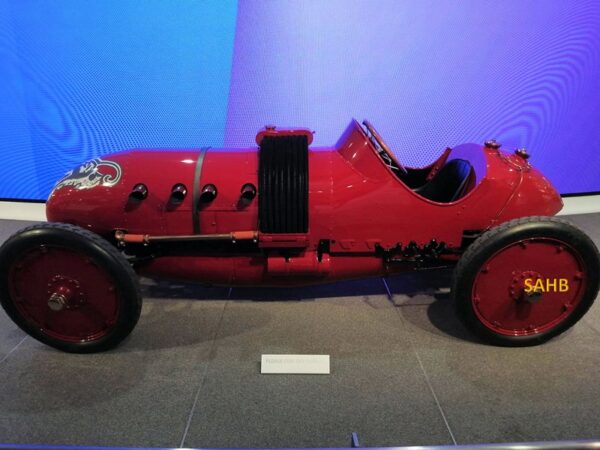
This is the Buick 60 Special, one of two built by Buick in 1910. It is one of the first US-built cars with just a single centrally located driver’s seat, in the days when almost all racing cars had a seat for the racing mechanic alongside that for the driver. General Motors founder William Crapo “Billy” Durant pursued motor racing for its promotional and sales value. He customised road cars to enter in stock production racing classes, but these so-called “Buick Roadsters” were disqualified by the American Automobile Association’s Contest Board. The Buick 60 Special was built in response to that disqualification. It was designed jointly by Chief Engineer Enos Anson de Waters, Louis Chevrolet, and Burman. The car was built in just a few weeks by the Buick Engineering department for the Buick Racing Team.
Burman was assigned to drive one Buick 60 and Chevrolet the other. Chevrolet’s car suffered a roll-over crash at the Indianapolis Motor Speedway on 29 June 1910 due to a blown tyre. Chevrolet attributed his survival to having ducked down into the car when it rolled, where he was protected by steel bands built into the car’s bonnet. His car was repaired, but in 1911 it disappeared, and its fate remains unknown. This surviving 60 Special is believed to be Burman’s. It was found in a warehouse in Kansas City. Charles S. Howard, president of the Howard Automobile Company, a Buick distributorship, bought the car, possibly from Burman’s widow, and showed it in 1920. He donated the car to the De Young Museum in San Francisco, then borrowed it back to display at his dealership. By 1940 the car had been restored by de Waters and his successor at Buick, Charles A. Chayne, in preparation for appearances at the Flint Motor Festival and New York World’s Fair that year. Ownership of the 60 Special passed to Chayne, who later donated the car to the Sloan Museum.
The car’s engine is an inline four-cylinder with the cylinders cast in pairs. It is an example of Buick’s “Valve-in-Head” engine, a design variously attributed to Walter Marr, David Dunbar Buick, and his assistant Eugene Richard. The four short exhaust pipes exiting from the left side of the engine cover are thought to be the inspiration for Buick’s famous porthole styling feature that was seen, albeit in vestigial from, as late as the mid-1960s. The “60” in the car’s name represents the engine’s power output, but this was probably a deliberate understatement: its true output has been estimated as 144–145bhp. The cooling system is remarkable. Heat from the engine passes through a series of finned tubes that arch over the car’s body just ahead of the scuttle. This allows the car to have a fully closed nose.
During testing of both cars at Indianapolis on 1 July 1910, Burman’s car set a measured top speed of 105.87mph. Burman won the first four events at the New Orleans Mardi Gras Races in 1911 with his 60 Special. Also in 1911, Burman and his car won a Straightaway Free-for-all race at Jacksonville Beach, Florida at an average speed of 91.06mph.
Photo courtesy of Guy Loveridge







Leave a Comment